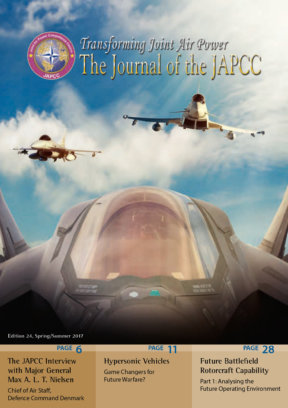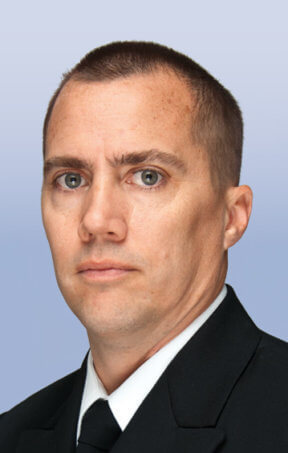Integrating 5th Generation Aircraft into the Joint Battlespace
Both the F-22 and F-35 have proprietary, directional datalink systems, which permit a high level of secure data transfer with each other, but have limited to no connectivity to other platforms. Many engineering solutions, including external datalink pods and other networking solutions, are under development to address this issue. However, the desire to incorporate these capabilities into the joint battlespace introduces a debate about how best to integrate these new systems with legacy platforms within conventional Command and Control (C2) structures. Integration may be achieved either through technological means (creating a datalink which passes information across generations) or through training. The latter would necessitate an improvement in NATO’s high-end, multi-component live training, which would have to occur against a quality adversary with a realistic rule set governing adjudication and the conduct of the exercise. This is critical not only for assessing NATO’s current preparedness for operations in this demanding and contested environment, but also for identifying shortfalls and focal points for improvement.
Further Challenges for the Alliance to Consider
Acceptance. Some nations operating legacy aircraft may struggle to accept being tactically dependent on 5th generation assets, flown by another nation, for targeting and engagement. This means that using 5th generation aircraft to detect, inform, and direct legacy aircraft serving as ‘missile trucks’ would likely not be accepted in the same way by every nation and in each tactical scenario.
Restrictions and Caveats. Shared locations/briefings/missions/training airspace and dispersal plans with other Coalition assets will initially be challenging due to national restrictions, sensors and communications compatibility, need to know, software upgrade costs and other factors. A ‘plug and play’ multinational force is desirable, but is likely not achievable in the near term due to national caveats regarding information sharing.
Cross Servicing. The viability of cross servicing among multinational F-35 users is questionable, and although NATO is currently re-invigorating its logistics and cross-servicing arrangement, those procedures are far from being codified. Furthermore, different users will have different arrangements with Industry. Maintenance contracts will differ from nation to nation, making cross-servicing even more challenging.
Airspace Saturation. Airspace saturation with manned aircraft, or the usage of Remotely Piloted Aircraft (RPA) or Miniature Air Launched Decoys (MALDs) by the adversary, among other tactics, could potentially negate a successful air-to-air reliance on the F-35 alone. This reinforces the concept that 5th generation and legacy aircraft must operate together in the future battlespace, as the war will not be won with only 5th generation aircraft.
Support versus Replace. Fifth generation assets are not the single solution for Anti-Access Area Denial (A2AD) layered defence systems. Rather they may become part of a more holistic and integrated solution when paired together and connected with other weapons and sensors, such as direct energy weapons or unmanned aerial vehicle swarms such as the Gremlins – a concept developed under the US Defense Advanced Research Projects Agency (DARPA).2 If leveraged correctly, this could be a true benefit of 5th generation aircraft. However, the Alliance should also be cautioned to remember that mass has a quality in warfare, and that advent of 5th Generation technology in many nations inventory will replace not add to the existing 4th Generation systems, in many cases in smaller numbers than exist today.
Different Employment Perspectives. Some opine that operators of 5th generation technology will elevate beyond a pure ‘sub-element operator’ role (and even beyond the classic mission commander role) into a partial C2 node, which enhances resiliency and improves task completion and information distribution functions. This perspective is not shared by all NATO nations participating in the F-35 program, but it is perhaps too early to make an accurate prediction as to what level this vision will be realized.
The crux of the integration challenge issue remains ensuring information fusion among and across the disparate platforms which currently are – and will be in the near future – in use across the spectrum of NATO’s Joint Air Power. Fifth generation fighters won’t win the war themselves, rather they will improve the capability of each legacy platform, once the technical challenges of interoperability are solved. As Lieutenant Colonel George Watkins, Commander of the USAF 34th Fighter Squadron concluded after Exercise Red Flag 2017-1, ‘[where it had previously been required to employ numerous 4th generation aircraft just to find and engage a single threat, …] now we are seeing three or four […] threats at a time. Just between the [5th generation aircraft], we are able to geolocate them, precision-target them, and then we are able to bring the 4th generation assets in behind us after those threats are neutralized. It’s a whole different world out there for us now. When you pair the [5th generation aircraft] together with the 4th generation strikers behind us, we’re really able to dominate the airspace.’3
JAPCC Project: Air Warfare Communication in a Networked Environment
To address the crux information fusion issue noted earlier, the JAPCC will soon publish a study ‘Air Warfare Communication in a Networked Environment’ which explores not only the interoperability challenges between current 5th generation and legacy aircraft, but also examines, from an interdisciplinary perspective, the fundamental relationship between air platforms viewed as a function of the communications capability. These concepts are then extrapolated onto the future operational environment where air platforms operate with hyper-connectivity in a robust, networked environment which enables machine-to-machine coordination. As communications capability increases, machines are able to self-synchronize the spatial orientation of weapons and sensors throughout the battlespace, allowing for more efficient use of those systems at a much higher decision speed than today’s airspace management and decision making structure permits.
Hyper-connected platforms will likely become mutually supporting from a bottom-up perspective. Establishing a hierarchy within their functions and roles may solve these mutual support needs. This can be achieved by the depiction, in real time, of who has the best available position, sensor or weapon.
Contextually, the force, comprised of individual platforms, will then behave as a singular entity operating at faster speeds, enabled by communication. One platform’s sensor may coordinate for a second platform’s weapons system to engage while using a third platform as a jammer, or as a SEAD asset with the proper platform´s configuration. Altogether, they would share a software-driven spatial motion policy and behave as a single organism.
Unlimited connectivity is no longer a concept for the future; however, combined decision-making and data sharing are not evolving at the same speed as technology. Furthermore, tactical scenarios that require the integration of 4th, 5th, and future generation assets will have to be analysed under a new, more general C2 concept to avoid mixing tomorrow’s capabilities with yesterday’s C2 structures. The impact of 5th and beyond generation air platforms will be realized through the development of spatial awareness using advanced sensors and sharing that information across the network to enable more efficient spatial distribution of resources, which may reduce the commander’s decision making timeline accordingly.
The authors created the term Dynamic Airspace Synchronization (DyAS) to describe how machines will communicate at hyperspeeds to self-synchronize for efficient airspace utilization, including weapons and sensor employment. The resultant battlespace will allow multiple platforms to appear to operate as a singular organism. The study concludes that the future battlespace may be choreographed and orchestrated by machines (a machine-managed order of battle) while retaining the ethical necessity of a human decision maker for certain kinetic functions.
Conclusion
The JAPCC believes that solving the Information Sharing element of Integration will be the key to unlocking many of the other issues identified in this article. Some headway with technical solutions has been made already (Talon HATE pod4 for example) but these solutions reside mostly within national channels and will require further coordination to achieve the same interoperability across the Alliance. Most of the additional challenges identified in this article can, and will, be solved through evolving doctrine and training, or addressed through modifications to international agreements (e.g. aircraft cross-servicing) as nations gain initial operational capability and begin working together. These challenges are not appreciably different from those faced by NATO in the past when a new technology arrived for use (Link 16 for example). Information fusion and C2 integration may be a tougher nut to crack, but is essential for the future of effective Alliance air power. 5th Generation aircraft in the joint fight can improve battlespace awareness, which when properly networked and shared across the force with legacy aircraft, will likely result in a tangible increase in overall combat effectiveness. Integrating manned and unmanned systems while leveraging the capabilities of machine speed communications, both within the cockpit and among platforms throughout the joint battlespace, are requisite to maximize the capability of the future air force. This requires the development of a more robust datalink, or network of links, to permit an even higher level of information exchange across the networked force, which could then leverage machine-to-machine communication, integrate some levels of automation to formation and sensor employment, and result in a more streamlined and effective Command and Control structure for the Alliance.














